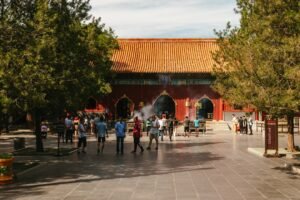

The NLS Pedagogy: A Deep Dive into the Methodology of Effective Arabic Language Acquisition
Choosing to learn a new language, especially one as rich and complex as Arabic, is a significant undertaking. The success of this journey hinges not just on the student’s dedication, but profoundly on the pedagogical approach of the institution they choose. The NLS Norwegian Language School has built a formidable reputation for its Arabic summer courses precisely because it has cultivated a learning ecosystem based on proven, modern, and holistic teaching methodologies. This is not a program built on rote memorization and dusty textbooks. Instead, it is a dynamic and interactive experience designed for deep comprehension and practical application. This article will take a closer look under the hood of the NLS pedagogy, deconstructing the framework, methods, and principles that make learning Arabic here an effective and deeply engaging pursuit.
Table of Contents
ToggleThe Bedrock: Aligning with the Common European Framework of Reference (CEFR)
At the core of the NLS curriculum design is its alignment with the Common European Framework of Reference for Languages (CEFR). While many schools cite the CEFR, NLS integrates it as a living blueprint for student progression. This framework is far more than a simple grading system; it’s a detailed descriptor of what a learner can actually do with the language at various stages.
-
A0-A1 (Beginner): When a student begins at the A0 level, they are a true novice. By the end of the A1 level, the goal is concrete. The student can understand and use familiar, everyday expressions and very basic phrases. They can introduce themselves and others, ask and answer basic personal questions (where they live, people they know), and interact in a simple way, provided the other person talks slowly and clearly. The NLS curriculum for this level focuses on mastering the Arabic alphabet (abjad), basic greetings, introductions, and essential survival phrases, building a solid and confident foundation.
-
A2 (Elementary): At this stage, the focus shifts to building upon that foundation. An A2 student can understand sentences and frequently used expressions related to areas of most immediate relevance (e.g., very basic personal and family information, shopping, local geography, employment). They can communicate in simple and routine tasks requiring a direct exchange of information on familiar matters. The NLS methodology here involves more complex role-playing, such as ordering a full meal, describing one’s family, or talking about daily routines, using past and present tenses.
-
B1 (Intermediate): This is a crucial turning point where a learner moves from basic survival language to genuine conversation. A B1 student can understand the main points of clear standard input on familiar matters regularly encountered in work, school, and leisure. They can deal with most situations likely to arise whilst travelling in an area where the language is spoken. They can produce simple connected text on topics which are familiar or of personal interest and can describe experiences, events, dreams, hopes, and ambitions. At NLS, B1 classes engage with more authentic materials like short news articles, song lyrics, and simple video clips. Class discussions become more nuanced, and students are challenged to express their opinions and justify them.
-
B2-C1 (Upper-Intermediate to Advanced): These higher levels aim for fluency and sophistication. A B2 learner can understand the main ideas of complex text on both concrete and abstract topics, including technical discussions in their field of specialisation. They can interact with a degree of fluency and spontaneity that makes regular interaction with native speakers quite possible. The C1 level, the highest offered in the summer course, aims for a student to express themselves fluently and spontaneously without much obvious searching for expressions, using language flexibly and effectively for social, academic, and professional purposes. The NLS pedagogy for these levels incorporates debate, formal presentations, analysis of Arabic literature and media, and a deep dive into the subtleties of dialect and register.
This CEFR structure ensures that students are placed in the correct learning environment, that their progress is measurable and logical, and that the skills they acquire are benchmarked against an international standard, giving real value to their certificate.
The Engine: Communicative Language Teaching (CLT)
The primary engine driving daily lessons at NLS is the Communicative Language Teaching (CLT) approach. This modern methodology represents a fundamental shift away from traditional teaching methods that prioritized knowledge about the language (e.g., memorizing grammar rules) towards the ability to use the language.
The core principles of CLT as practiced at NLS include:
- Interaction is Paramount: Language is learned through using it to communicate. The classroom is a space for constant, meaningful interaction. From day one, students are encouraged to speak, even if they make mistakes. Pair work, group discussions, and interactive tasks are the norm, not the exception.
- Authentic Materials: Learning is more effective when it involves authentic texts—materials created for native speakers, not for language learners. While beginners start with adapted texts, they are quickly introduced to real-world materials like menus, train schedules, simple songs, and advertisements. This prepares them for the language as it is actually used.
- Focus on Fluency and Accuracy: Traditional methods often focused so heavily on grammatical accuracy that students were afraid to speak. CLT balances this by valuing fluency—the ability to communicate a message effectively. The NLS instructors create a supportive environment where students can express themselves without fear of judgment, while providing gentle, constructive correction to improve accuracy over time.
- Language in Context: Grammar and vocabulary are not taught as isolated lists. They are presented and practiced in the context of a real-world situation. For instance, instead of just learning past tense verb conjugations, students will tell a story about what they did last weekend. This contextualization makes the language more memorable and more readily usable.
This approach ensures that graduates of the NLS program are not just “book-smart.” They can actually function and communicate in Arabic, which is the ultimate goal of any language learner. If this effective, modern approach to learning sounds right for you, you can explore the course details and begin your journey. Registration is now open for the summer session at https://nlsnorwegian.no/arabic-summer-courses/.
The Human Element: The Instructor as Facilitator and Cultural Guide
No methodology can succeed without skilled practitioners. NLS places immense importance on the quality of its instructors. They are not simply lecturers who dispense information; they are trained facilitators of learning and passionate cultural guides.
All instructors are native or near-native speakers with extensive teaching experience. This guarantees authentic pronunciation, intonation, and a natural feel for the language. However, their role goes far beyond being a language model. In a CLT classroom, the instructor’s job is to:
- Create Opportunities for Communication: They design tasks and activities that necessitate student interaction.
- Act as a Resource: They move around the classroom, listening, helping, and answering questions as students work through tasks.
- Provide Feedback: They offer targeted feedback on both language use and communicative effectiveness.
- Foster a Supportive Environment: They build a community of learners where students feel safe to take risks and make errors, understanding that this is an essential part of the learning process.
Furthermore, the instructors at NLS are cultural ambassadors. They infuse lessons with cultural insights, explaining the nuances behind certain phrases, the social etiquette of conversation, and the historical context of the language. This transforms the learning experience from a dry academic exercise into a vibrant cultural exploration.
The Soul of the Language: Cultural Integration as a Core Principle
At NLS, culture is not an afterthought or a “special topics” Friday lesson. It is woven into the very fabric of the curriculum. The school operates on the principle that language and culture are inextricably linked. To speak Arabic fluently is to understand the cultural concepts it expresses.
This integration happens in multiple ways:
- Politeness Formulas: Learners are taught not just “please” and “thank you,” but the rich array of politeness formulas central to Arab hospitality and social interaction. Phrases like “تفضل” (tafaḍḍal) have no single English equivalent but are essential for everything from welcoming a guest to offering a seat.
- Proverbs and Idioms: The curriculum introduces students to common Arabic proverbs and idioms. Learning these provides a window into the cultural values and shared history of the Arab world.
- Non-Verbal Communication: Instructors discuss and model appropriate body language, gestures, and concepts of personal space, which can differ significantly from Norwegian norms.
- Thematic Cultural Workshops: Beyond the classroom, dedicated workshops on calligraphy, music, or cuisine provide hands-on experiences that create deeper, more memorable connections to the culture.
By embracing this holistic approach, NLS ensures its students develop not just linguistic competence but true intercultural competence, a vital skill for anyone wishing to build meaningful relationships with Arabic speakers.
If you are ready to experience a language program that values deep cultural understanding as much as grammatical precision, the NLS summer courses are the ideal choice. To join this vibrant learning community, secure your place by registering at https://nlsnorwegian.no/arabic-summer-courses/.
In conclusion, the success of the NLS Arabic summer courses lies in a sophisticated and thoughtfully designed pedagogical ecosystem. The clear, internationally recognized progression of the CEFR provides the structure. The dynamic, interactive methodology of Communicative Language Teaching provides the engine. Highly skilled and passionate instructors provide the expert guidance. And a deep, unwavering commitment to cultural integration provides the soul. It is this powerful combination that transforms the daunting task of learning Arabic into an achievable, enjoyable, and profoundly rewarding journey. This is not just a course; it is a comprehensive training ground for becoming a confident and culturally aware speaker of Arabic.
To be a part of this effective and engaging learning environment this summer, take the next step. Your place in a class designed for real-world communication and cultural discovery is waiting. Complete your registration today at https://nlsnorwegian.no/arabic-summer-courses/
If you want to learn Norwegian, you can register for classes here. We look forward to hearing from you and helping you become fluent in Norwegian.





